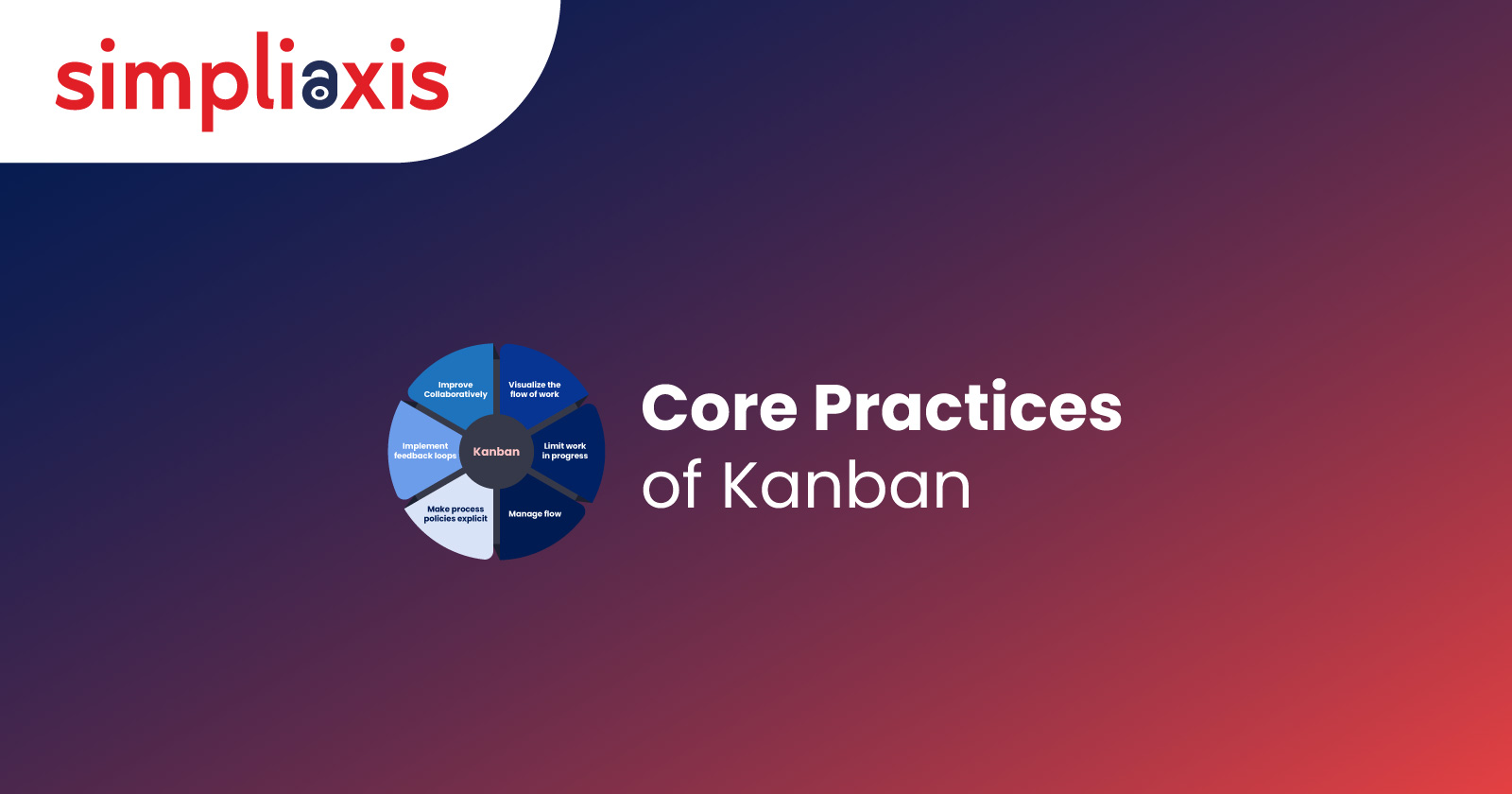Kanban is a pull-based system which means whenever a deliverable is required, you can start working on it. Some certain principles and practices are followed in Kanban so that work glows smoothly. While the principles of Kanban describe how to take up change in your organization, the Kanban practices show how you can consistently evoke the desire for change in the people in your organization. The aim is to improve the workflow, leading to more customer satisfaction. These Kanban practices also tell us which activities should be controlled and managed for better workflow. Since Kanban is supposed to facilitate continuous improvement, it follows a few simple rules called practices to generate behaviors. In this article, we will discuss these core practices of Kanban in detail. But before we start discussing these practices, it is essential to understand the workflow.
What is workflow
Any product or service starts with a concept and ends with being delivered in its actual form, which may be tangible or intangible. Every step you follow between these two ends, i.e., conception to delivery, is the workflow in Kanban. A Kanban workflow contains clear-cut principles and practices followed at every stage by the team while the work flows through different stages of the process. Every workflow through multiple process stages and workflow differs for different processes. Therefore, the Kanban teams mustn't be forced to follow a particular workflow. In Kanban, this workflow is planned, operated, and managed by a Kanban board. We will discuss the Kanban board in another article. Right now, let us focus on Kanban practices.
Kanban practices
There are six core practices of Kanban. These are:
1. Visualize the flow of work
You may call it one of the essential Kanban practices. you have a Kanban tool that helps you visualize an entire project on a single board. Visualization is done through cards on the board, with each card representing a user story or work in the product backlog. You may use different colors to represent different themes of user stories. You have to make three columns on the board. One for 'work to be done, 'work in progress (WIP), and 'work done.' Now put the cards in each column depending on the work status. Remember, each card must contain the work details like its name, duration, starting and finishing time, and the resource name. More stages can be added according to a particular process, like there can be a review stage between the Work in Progress and the Done stage. This order of operations in different stages of a process is called workflow. When this kind of information is regularly updated, and information is always readily available, it shows that the system is working healthily. Apart from visualizing the workflow, there are many more things to visualize that aid decision-making. This kind of visualization gives the whole team the status and progress of each task and the management a clear picture of what is happening and what will happen in the organization. The cards are moved from one column to the other as the work progresses. And this way, the workflow is constantly monitored, likely bottlenecks identified and resolved before they get too serious.
2. Limiting the work in progress
Limiting Work In Progress (WIP) is at the core of the Kanban system because it is a pull system. Limiting WIP is critical to reducing cost and delivery time otherwise, it produces more partially done work with little or no value. With a limited WIP, your team learns first to complete the task they are working on and take up further work only after that. This is a very sound policy for reducing wastage also. Limiting WIP also helps optimize the tasks so that WIP is not overburdened with tasks. So, you must limit how much work should be in WIP at any given time and should be displayed in the cards in the WIP column on the board. So, on a Kanban board, once you set the limit to the work packages in the WIP column when it is filled, you will know that the team can not take any more work.
This means the thinking pattern shifts from focusing on the efficiency of resources to the efficiency of the workflow. Without limiting WIP, your resources may feel overwhelmed by the work at hand and compromise quality. So, limiting WIP is essential to delivering high-quality products.
3. Managing the flow of work
The essence of a good Kanban system is to manage and improve the workflow. Once you have put the workflow on the board, it becomes straightforward to manage the flow because the Kanban system highlights the different stages of the workflow and the state of work in each stage. At every stage, you can see how much work has flowed from the left to the right side, from the 'to make' list to the 'done' list and how much the WIP is. It is a very effective tool for managing your workflow. The cards on the board display the real-time flow of the work so that you get an immediate indication of any disruption and may promptly work to remove it for smooth flow of the work—a smooth flow of work results in the creation of more value. Your focus has to be on the workflow. From the board, you can analyze the time being taken by a card to move from one column to the next. You get a clear picture of WIP to keep it within the decided limits. Overall, the Kanban board allows you to manage your workflow efficiently. Managing workflow is crucial to achieving consistency and punctuality. Managing workflow efficiently involves focusing on different process components like tasks, team, technology, and product. And focusing on customer needs enables you to focus on all other points of focus correctly. Identifying and removing impediments in the process cycle are signs of efficient workflow management. A smooth workflow results from managing the system and not the people.
4. Transparency in process policies
Next in the line of core practices of Kanban is making explicit policies. Everything was done in the process, and all decisions should be transparent. Transparency makes a big difference to the overall performance of an organization. This is the difference between a high-performing organization and an average one. The individual members of a team perform so many tasks and make many decisions individually. These must be clear to every member of the team or the organization as a whole, as the case may be. If these things are not transparent, people may start assuming, which is dangerous for processes and hamper the workflow. Assumptions do not run companies. They are run by specific ground rules which are clear to all concerned. Therefore, things like WIP policy, the available resources, and what will be considered as Done should be clear to everyone concerned. When issues and rules are clear to everyone, the team discussions become more rational and result-oriented. Practicing transparency acts as a confidence-building measure among the people of the organization. It also promotes initiative and encourages team members to collaborate more effectively with others. Making too complicated policies may result in gaps in communication or misunderstanding. So, they must be simple and easy to understand. And most of all, make all policies visible to all.
5. Implement a Feedback loop
Feedback is not only an essential but integral part of Kanban. If you want to bring change to the entire organization, all the departments and services using the Kanban system must be effectively interconnected. And feedback loops keep them interconnected. Feedback plays an integral part in continuous improvement. Regular feedback conveys the signs if your Kanban system is going off-track. Feedback loops drive change when they bring transparency. From time to time, information is shared through feedback loops for continuous improvement, thus connecting decision-makers at different levels. Feedback is received at different stages of the process, and the Kanban system encourages the building of feedback loops which are reviewed in different types of meetings. Feedback loops are also essential to ensure you deliver the proper functionality or product at the right time with the right quality. The feedback can be within the team, between the teams, between the manager and the team, or between the customer and the organization.
And a Stand-Up meeting is a chance to get feedback at different levels. These short meetings are held regularly, and as the name suggests, these meetings are so short to enable team members to keep standing during the whole duration of the meeting. Once the team has the feedback and the Kanban board in front of it, they can view what task they should take up and how it should be done. Decisions are taken regarding when action has to be taken to move a work package forward and when the system's working should be reviewed. Feedback loops also encourage a culture of learning. So, implementing feedback loops becomes very important to ensure that the system is working correctly and the team is moving in the right direction.
6. Improve collaboratively, evolve experimentally
Improve collaboratively, and evolving experimentally is the core practice of Kanban and is the method for continuous improvement. For continuous improvement, cooperation and coordination among the people are imperative. Cooperation is essential if you want your organization to work efficiently and improve consistently. The efficient delivery of products and services needs cooperation and collaboration. Your work is not completed once you implement Kanban. Improvement has to go on. Kanban is all about improving continuously. It has to be an ongoing process. So, keep evaluating your processes and keep making the needed changes that bring improvement. The improvement process may include increasing the value to be delivered to the customer in every project and changes in organizational behavior. Etc. Continuous improvement also means adopting beneficial changes and discarding those that do not serve a purpose. Kanban is not a one-time system. It manages continuous improvement with the constant evolution of the processes and practices.
These Kanban practices are meant to improve the overall performance of the processes and the organization. It is all about how you implement the change and how you manage that change. A change in the process is not limited to the process, it affects the whole organizational behavior, and the key is dealing with it. That is where practices like transparency, feedback loop, and continuous improvement play an essential role. So, what the people in your organization learn from these core practices of Kanban is how their work and system function, enabling you to be proactive in leading the change.
Conclusion:
In conclusion, the core practices of Kanban form the foundation for effective workflow management and continuous improvement within organizations. By visualizing the flow of work, limiting work in progress, managing the flow, ensuring transparency in process policies, implementing feedback loops, and fostering collaborative improvement, Kanban enables teams to optimize processes and deliver value consistently. These practices empower organizations to adapt to changing requirements, address bottlenecks proactively, and foster a culture of learning and innovation. Simpliaxis offers Agile Fundamentals including Scrum and Kanban Training to equip individuals with the necessary skills to implement these practices effectively and drive organizational success.



















